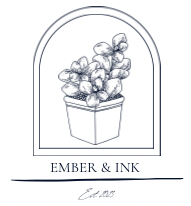Studio



emBEr & ink
Studio
Est. 2023
GRAND OPENING AUGUST 2023
My vision is to curate a organic and nurturing environment, where I can offer my services to members of my community in an inclusive & safe space. My services are predominantly geared towards members of my community who identify as female, however everyone is always welcomed and celebrated for their individuality. My mission is to help women embrace their natural beauty and provide them with tools to help them reclaim and love their bodies and minds.
My objective is to help build individuals up and rediscover their confidence, so they can tackle any challenges they face. But that all starts from loving yourself, and I hope to help everyone who walks through my door recognize and embrace their beauty.
My services include permanent makeup (PMU) & tiny tattoos, however my focus is Paramedical Micropigmentation Correction and Skin Rejuvenation. These services range from stretch mark and scar corrections, to areola reconstruction and large surgery scar correction/resurfacing. A large percentage of these services are for members of our community going through cancer treatment, truama recovery or gender affirming surgeries. I strive to offer the most personalized experience, backed with clinical knowledge and education. Im proud to only offer my services with the cleanest vegan pigments and inks that meet the highest global standards (approved for use in EU – R.E.A.CH program adherence)
We respect those who came before us and acknowledge that we operate on Treaty 7 land—home to the Kainai, Piikani, Siksika, Tsuu T’ina, Îyâxe Nakoda and Metis Nation Region 3.
Inks & Pigments used
Traditional tattoo ink – What does it contain?
When It comes to tattoo ink, color is more likely to contain metals and other “worrisome” ingredients
• Blue – cobalt & copper
• Green -chromium, lead, aluminium
• Red – iron, cadmium, mercury
• White -barium, zinc, lead, titanium
• Yellow – zinc, lead, cadmium
While black pigment is considered a safe choice, there are two different types. They are classified as liner and shader inks. The color red is known to be the most problematic and reactive of all pigments. Allergic reactions have been reported years after healed
Europe has a much higher standard of quality that ink producers must adhere to (R.E.A.CH program) while the vast majority of the world is still heavily unregulated (including the FDA- not regulated). It is important to understand that any tattoo posses the risk of micro or nano particles traveling through the blood stream and can becoming deposited else where ie. lymph nodes
Vegan and organic pigments are vegetable based and less harmful than mineral base. However AZO pigments can still be found in vegan/organic piments. Azo pigments may contain carcinogens depending on color.
Over 80% of vegan/organic inks are carbon based and roughly 60% contain azo. So vegan doesn’t always mean more safe. Look for vegan and non toxic pigments such as
• Black- Carbon and logwood
• White- Titanium dioxide
• Yellow- Turmeric
• Green-Monoazo
• Blue-Sodium and aluminum
• Red-Naphthol
• Purple- Dioxazine and carbazole
PMU VS. Tattoo – PMU Pigment compared to Traditional Tattoo Ink
Though fundamentally both processes deposit ink into the skin in a similar fashion, the inks/pigments used in each are vastly different. Unlike traditional tattoo ink, PMU pigments are designed to fade. The particles are much smaller than the ones found in traditional tattoo ink. PMU pigments are deposited in the epidermis at a about 1/3 the depth of traditional ink. These much smaller particles heal with a much soft and natural appearance. The depth and proper pigment selection by a trained professional ensures the ability for the body to properly retain and then shed the pigments, so they can be modified over time as your appearance changes. Improper selection of carbon based pigments or technique could leave you with more permanent results.
Traditional tattoo ink differs in this way as is it is designed to go deeper into the epidermis and ideally stay for life. Larger carbon based particles have the best retention and ability to stayindefinitely as your body cant fully break down and metabolise the particles
| PMU Pigment | Traditional Tattoo Ink |
| • Either inorganic (iron oxide) or Organic (carbon) pigments with a water or glycerine base • Designed to fade • Less concentrated • Smaller particles • Placed in epidermis • Almost exclusively a rotary machine • 0.2-0.28 mm needles | • Made from pigments, carriers, and added chemicals ie) lead, chromium, nickel, titanium dioxide, etc • Designed to stay • 80% are carbon • 60% contain azo • More concentrated • Larger particles • Placed deeper in the epidermis • Predominantly coil machines • Commonly 0.3-0.4 mm needles |
PMU Pigments – Composition
PMU piments can be broken down into 2 categories.
| Organic pigment – Carbon | Inorganic pigment – Iron oxide |
| • Better retention – last longer • Smaller particle size • Highly pigmented – spreads • Can stay “forever” • Lasers away easier • Avoid for microblading as it “blurs” over time • Almost always used for eyeliner • Black carbon wont shift red – heals cool | • Will fade with proper technique • Larger particle size • Easier to work with (less wiping=better stencil hold) • More friendly for beginners • More likely to be used • Better for older clients as they tend to heal cool • Fades warmer because the particles break down and turn to red as its broken down and metabolized |
Top brands include Clinitq, Biotek, Phi, Chanco
What you should be asking when choosing your service provider
- Where did you complete your training? Was it an in person course at an institute or an online kit?
- What pigments/inks do you use? Are they EU approved?
How To book
EMBER & INK
UNION YYC ~ BOW 45
4620 BOW TRAIL S.W.
3RD FLOOR
CALGARY, A.B.
T3C 2G6
